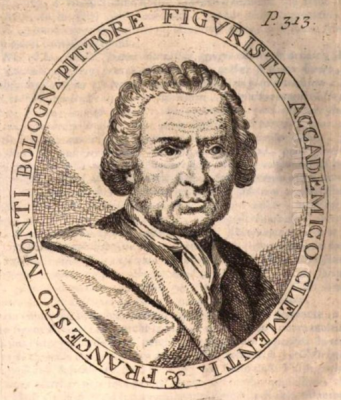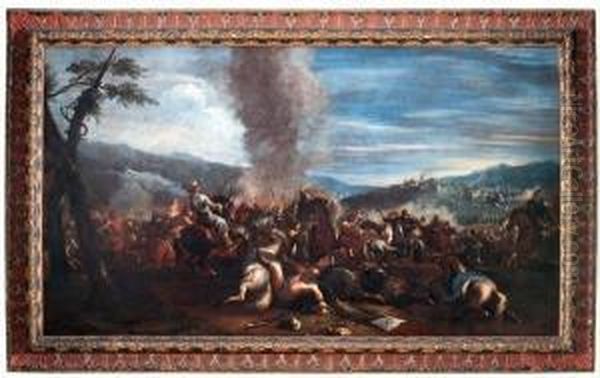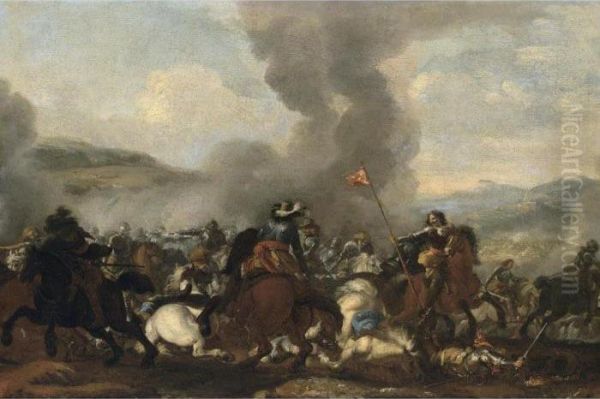
Francesco Monti, an Italian painter born in Brescia in 1646, carved a distinct niche for himself within the vibrant artistic landscape of the late Baroque period. He became renowned primarily for his dramatic and energetic depictions of battle scenes, earning him the evocative nickname "il Bresciano delle Battaglie," which translates to "the Brescian of the Battles." His specialization in this genre, coupled with his skillful execution, positioned him as a significant figure, particularly appreciated for capturing the chaos and dynamism of military conflict and equestrian subjects. He navigated the artistic currents of Northern Italy, leaving his mark in several major cities before his death in 1712.
Early Life and Training in Brescia
Born into the Lombard city of Brescia, Monti's artistic journey began under the tutelage of notable painters. Sources confirm his apprenticeship with Pietro Ricci, also known as Pietro Ricchi or 'il Lucchese', an artist active in the region. Perhaps more significantly for his future specialization, Monti also studied with Jacques Courtois. Courtois, a French painter highly active in Italy, was himself celebrated under the names Giacomo Cortese or 'Il Borgognone' and was arguably the pre-eminent battle painter of his generation working in Rome and Florence.
The influence of Courtois is palpable in Monti's choice of subject matter and likely stylistic approach. Learning from such a master of the battaglia genre undoubtedly provided Monti with a strong foundation in composing complex scenes involving numerous figures, horses in dynamic motion, and the dramatic interplay of light and shadow characteristic of Baroque aesthetics. Brescia itself had a rich artistic heritage, home to earlier masters like Moretto da Brescia and Girolamo Romanino, fostering an environment where artistic skill was valued, though Monti's path would lead him towards a more specialized, action-oriented form of painting.
Artistic Style: The Energetic Brush of 'Della Battaglia'

Francesco Monti's reputation was built on his ability to infuse his canvases with energy and movement. His battle scenes were not static representations but aimed to capture the visceral intensity of combat. This focus earned him another moniker, "Della Battaglia" – "of the Battle" – highlighting his complete identification with the genre. His style is characterized by a lively dynamism, particularly evident in the rendering of horses, which were central elements in the cavalry engagements he frequently depicted.
Typical of Baroque battle painting, Monti's works likely employed strong contrasts of light and dark (chiaroscuro) to heighten the drama and focus attention on key moments within the fray. Compositions would feature swirling masses of figures, clashing soldiers, rearing horses, and the general tumult of war. Attention to detail in armour, weaponry, and military attire would have been important for conveying realism and satisfying patrons, who often included military figures or aristocrats desiring depictions of martial prowess. His approach can be situated within a tradition that included artists like Salvator Rosa, known for his wild landscapes and battle scenes, and Michelangelo Cerquozzi, another specialist in the genre active in Rome.
A Career Across Northern Italy
While originating from Brescia, Monti's professional life unfolded across several important artistic centers in Northern Italy. His presence is documented primarily in Parma, a city historically under the influence of the Farnese family, known patrons of the arts. It is highly probable that Monti found commissions there among the local nobility, perhaps creating works that glorified military history or simply catered to the contemporary taste for dramatic battle pictures.
His travels also took him to Bologna, a powerhouse of Italian painting throughout the Baroque era. Here, he would have been working in an environment shaped by the legacy of the Carracci and contemporaries such as Carlo Cignani and Marcantonio Franceschini. Later, figures like Donato Creti and Giuseppe Maria Crespi would continue the city's artistic prominence. Monti's specialization likely offered a distinct alternative to the predominantly religious and mythological themes favoured by many Bolognese painters.
Furthermore, Monti worked in Florence, the cradle of the Renaissance, which still maintained significant artistic activity under the later Medici dukes. Artists like Pandolfo Reschi, another painter known for battle scenes and landscapes, were active there during a similar period. Finally, Monti's presence is noted in Venice, the opulent maritime republic, always a cosmopolitan center attracting artists and patrons from across Europe. Working in these diverse cities exposed Monti to various influences and provided ample opportunities for patronage from prominent families seeking to adorn their palaces with his vigorous compositions.
Representative Works and Subject Matter

Among Monti's documented works, specific mention is made of paintings depicting the Battle of Vienna. This historical event, occurring in 1683 when the Ottoman siege of Vienna was broken by a coalition led by the Polish King John III Sobieski, was a subject of immense contemporary significance and popular artistic representation across Europe. Monti's rendition of this battle would have likely been a large-scale, complex work, demanding skill in marshalling numerous figures and capturing the specific historical context. One such painting is known to have been in the collection of Contessa Margherita Cavranzola before later moving to a private collection in New York.
Beyond specific historical events, Monti produced numerous works simply titled Battaglia (Battle). These generic battle scenes allowed for greater artistic freedom in composition and emphasis. A description of one such work highlights the depiction of European cavalry in characteristic style, featuring vivid colours and rich detail, underscoring his focus on the dynamic and visually arresting aspects of warfare. These paintings served not only as historical records but also as decorative pieces demonstrating the patron's sophisticated taste and appreciation for martial themes. The accurate and spirited depiction of horses was a key element of his appeal, a skill highly valued in equestrian portraits and battle scenes alike.
Legacy and Attribution Challenges
Francesco Monti's dedication to the battle genre contributed significantly to the continuation and evolution of this specific strand within late Italian Baroque painting. His energetic style and focus on dynamic action influenced how such scenes were conceived and executed. He stands as a notable example of artistic specialization during a period where versatility was also prized. His work reflects the demands of patrons interested in themes of power, conflict, and heroism, often expressed through the dramatic lens of the Baroque.
However, as with many artists of his time, particularly specialists whose style could be imitated, questions of attribution sometimes arise regarding works associated with Francesco Monti. Art historical scholarship occasionally debates the authorship of certain battle paintings from this period. The provided text mentions that some works stylistically similar to Monti's have been tentatively linked by critics to other artists, such as the vaguely referenced "Vivacoda" or Ascanio Luciani. Luciani, primarily known as a painter of architectural perspectives (quadratura), did sometimes collaborate with figure painters, making such connections plausible, though often difficult to definitively prove. These discussions highlight the complexities of connoisseurship and the ongoing research into the oeuvres of Baroque masters.
Distinguishing Monti 'Il Bresciano' from Namesakes
It is crucial for clarity to distinguish Francesco Monti 'Il Bresciano delle Battaglie' (1646-1712) from another notable Italian painter bearing the same name: Francesco Monti (1685-1768), who was primarily active in Bologna and later worked in Monti's native Brescia. This later Francesco Monti belonged to a subsequent generation and developed a different style, often characterized by finer lines and more structured compositions, influenced by Bolognese classicism and artists like Donato Creti, Carlo Cignani, and potentially Gian Gioseffo dal Sole (the source text mentions Salvi, Creti, and Aiello as influences for this later Monti).
The Bolognese Francesco Monti (1685-1768) worked extensively on religious commissions and frescoes, such as those mentioned in the source text for the church of San Matteo in Bologna (though this needs verification) and potentially other locations in Lombardy like Bagnolo Mella (works like La Nascita di Maria and L'Annunciazione) and Crespi d'Adda (frescoes in the parish church, originally San Gerolamo). Works like the drawing Standing Helmeted Male Nude Unsheathing a Dagger held by the Harvard Art Museums, and an oil painting of a meditating Saint Francis in the Musée Magnin in Dijon, are generally associated with this later, Bolognese Francesco Monti, not the battle painter 'Il Bresciano'. Recognizing these two distinct artistic personalities is essential for accurate art historical understanding.
Conclusion: A Specialist in Tumult
Francesco Monti 'Il Bresciano delle Battaglie' remains a significant figure in the history of Italian Baroque art, specifically celebrated for his mastery of the battle scene. Born in Brescia and trained by notable artists including the pre-eminent battle painter Jacques Courtois, Monti developed a dynamic and energetic style perfectly suited to capturing the chaos and grandeur of military engagements. His career took him through major artistic centers like Parma, Bologna, Florence, and Venice, where he found patronage among those who appreciated his specialized skill. While perhaps less famous than some of his contemporaries who tackled a broader range of subjects, like Luca Giordano or Giuseppe Maria Crespi, Monti's dedication to the battaglia genre secured his reputation. His works, such as the depictions of the Battle of Vienna, stand as testaments to his ability to translate the tumult of war into compelling visual narratives, leaving a distinct legacy within the rich tapestry of Italian painting.